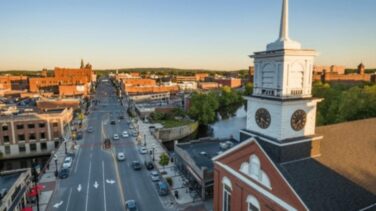While governments have scrambled to respond to the COVID-19 pandemic, citizens and small businesses have demonstrated both resilience and creativity in adapting outdoor and underutilized spaces to fit their new lifestyles.
 With fewer cars on the road, we’ve seen streets closed to vehicles and opened up to pedestrians and cyclists. Artists are sending messages of hope through their work across urban landscapes and guerilla gardens are popping up everywhere. Restaurants have utilized sidewalks and empty parking spaces to add additional outdoor seating for guests. Desolate parking lots have become a temporary home for pop-up retail and drive-in movies. In the U.K, residents even used spray paint to create informal runner’s lanes.
With fewer cars on the road, we’ve seen streets closed to vehicles and opened up to pedestrians and cyclists. Artists are sending messages of hope through their work across urban landscapes and guerilla gardens are popping up everywhere. Restaurants have utilized sidewalks and empty parking spaces to add additional outdoor seating for guests. Desolate parking lots have become a temporary home for pop-up retail and drive-in movies. In the U.K, residents even used spray paint to create informal runner’s lanes.
Although these urban interventions – known as tactical urbanism – have grown in popularity in recent years, they’ve become more prominent in response to COVID-19. These small-scale interventions are community-focused and offer easy-to-implement, inexpensive solutions to community needs. As we enter the next stage of the pandemic, how can we leverage this crisis to bring about positive change in our neighborhoods?
These projects are intended to serve as short-term improvements, yet they often demonstrate longer-term opportunities for community development. These initiatives start small, but they have the potential to power more permanent change as a form of placemaking. These projects serve as opportunities to test ideas and solicit feedback, and because it’s often community members spearheading the change, communities themselves have a sense of ownership over the space.
Many of these changes have been implemented as a way to enjoy underutilized spaces while maintaining social distancing, but they’ll also serve as a test to the type of communities we want to be: more resilient, better connected, and more eco-friendly.
Jonathan Berk, Director of Patronicity, reminds us that cities were constructed to safely and efficiently handle a large volume of people. “The choices we’ve made through our urban design patterns since that time have reallocated that space over the years and allocated it to moving automobiles through our cities. These decisions are what we need to rethink today as we look at get our local economies back up and running again in this new age where physical distancing is the name of the game.” In shifting the balance of public spaces towards people instead of cars, we’ll see not only safer, more enjoyable places for walking, cycling, and playing, but also additional benefits for the climate, economy, and overall health of the public.
The post-COVID era will lead to urban transformations across our cities and our communities. People will live, travel, and work much differently well into the future. As Berk mentions, “No one has the “silver bullet” solution to doing this properly and safely but we’re all going to have to be ready to learn and iterate the reopening of our main streets and downtowns.” Communities that are most willing to adapt and sustain such changes will see healthier, more inclusive, and most sustainable communities.
– The coUrbanize Marketing Team


